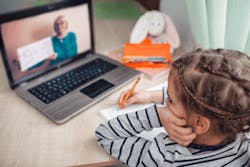Connecting America’s At-Home Classrooms
Collaborative Solutions Emerge —
KIPP University Prep High School sits at the center of San Antonio, Texas — a city of about 1.5 million people. Because it’s in an urban area, you’d expect to find Internet access in just about every nearby home but that’s simply not the case.
"Once we were told that the school would be closing because of COVID-19, laptops were distributed to students. Some parents picked them up, others needed them delivered," said Danielle White, a special education teacher at the charter school. "It wasn’t long before we realized that there were parents who did not have Internet access in their homes."
KIPP UPREP, as it’s referred to, serves 800 students in grades 9-12, and is part of the KIPP Texas Public School System. Nearly 88% of the student population in the school system is economically disadvantaged and 37% are English Language learners — which means some unique challenges when it comes to learning at home.
InvisiLight® Solution for Deploying Fiber
April 2, 2022Go to Market Faster. Speed up Network Deployment
April 2, 2022Episode 10: Fiber Optic Closure Specs Explained…
April 1, 2022Food for Thought from Our 2022 ICT Visionaries
April 1, 2022"We are in an area that has a large Hispanic population and high levels of poverty. We directed many of our parents who did not have Internet access to the Spectrum free Internet program," explained White. "But using the program meant parents had to do over-the-phone applications, and even with customer service speaking Spanish, many parents struggled to understand the process. They also had long waits. All of this meant there were large numbers of kids who could not use their laptops in a timely manner and got behind on their work."
Hispanics, African Americans, and low-income students, are expected to be the hardest hit by the Digital Divide during pandemic school closures. Models predict an overall loss of learning of 6.8 months as a result of a reliance on online learning and the virus.1
For low-income kids, the anticipated loss is 12.4 months; for African American children the anticipated loss is 10.3 months, and for Hispanic students it’s 9.3 months.
"This can have long lasting effects, such as increased school drop-out rates and economic challenges that will only widen the gap between the haves and the have-nots," said Chris McGovern, Director of Research Development, Connected Nation.
That sobering truth is why the 60 teachers at KIPP UPREP — like many others across the country — were scrambling this year to not only adjust their teaching for a virtual setting but also to find new ways to make sure each child actually had the access he or she needed to the online classroom.
"As a school, we communicated with each other to make sure everyone knew who was waiting on Internet and laptops, but it was still a struggle," said White. "I was working with my kids, making sure they could catch up, but having learning/emotional disabilities compounded the issue. In addition, many of our kids have to watch younger siblings or have to work during the day because many parents were laid off during the quarantine."
It’s not just vulnerable populations that are impacted. Children living in rural, urban, or suburban communities that do not have access to robust or adequate Internet service are also being left behind — and sometimes completely left out of the remote classroom.
"We live in a suburban area and are lucky to have access to the Internet," said Hillary Brown, a mother of 3 in Oregon. "However, we still struggled with slow connectivity when the schools shut down, resulting in my daughter, Haley, joining classes late or getting dropped from Zoom calls."
Right now, 19% of students — which is equivalent to about 10.6 million kids — do not have the Internet connectivity they need at home "impacting their ability to adequately participate in remote learning while schools are closed due to COVID-19." That’s according to research from Digital Wish, a national nonprofit that’s been working since 2008 to close the technology gap in the classroom.2
Issue #2. Administrators needed a rapid response plan if there was an outbreak in their district for when students and teachers eventually returned.
"Of course, this has been an unprecedented time. No one could have anticipated that teachers and students would suddenly have to take all learning to an at-home classroom," said Brent Legg, VP of Government Affairs, Connected Nation. "Now, with so many school districts having mixed classrooms or being completely virtual, we need to help administrators continue to navigate this new landscape. Part of that requires truly understanding which students do not have Internet access at home and, when they don’t, knowing how to begin to connect those kids."
Charting a New Path Forward
One of the things KIPP UPREP’s staff did right in the first few weeks of the pandemic was to help parents get Internet access, and ensure every student had a laptop. Digital Wish found that more than 21% (11.8 million) of students do not have access to a computing device.
As an alternative approach, some schools asked students to use their cell phones. "My daughter’s teachers all assumed the kids had cell phones of their own," said Brown. "The curriculum was built around them taking pictures of their tests and homework. I don’t allow Haley to have a phone, so she frequently had to turn things in late or get special dispensation from the teacher until I could get home and take and send pictures for her. Again, I feel like we are lucky and among the privileged ones. I can’t imagine trying to do online classes with the access we have even if it goes in and out at times."
"Really think about that for a moment. Imagine a high school student trying to type a history paper on a phone," said Heather Gate, Director of Digital Inclusion, Connected Nation. "Clearly students without a laptop or desktop computer at home, are at a significant disadvantage compared to their connected peers. So, we have two issues we must confront. One, the need for connectivity in every household with school-aged kids, and, two, the need for every student to have access to an Internet-enabled computer in the household."
COVID-19 has exposed the need for school districts to better understand the state of home connectivity and what access students have to devices. That means both school administrators and state leaders need assessments and data collection tools to identify both the opportunities and challenges for connectivity within their school districts.
"Our team at Connected Nation is hyper-focused on helping communities connect to high-speed Internet and its related technologies. That has included working with schools in places like Utah and Alaska to identify ways to improve technology access for students and teachers," said Emily Jordan, VP of Connect K-12, Connected Nation. "We partnered this year with Funds for Learning to continue the mission of EducationSuperHighway to help school districts navigate options for providing better connectivity directly to classrooms — launching our Connect K-12 Program just a short time ago."
Connect K-12 is a free Internet speed and pricing information tool that provides actionable intelligence for America’s K-12 school districts. It was designed specifically as a resource for leaders in state government and for school district administrators, including superintendents and technology directors, who are helping school districts upgrade their connectivity.3
In addition, EducationSuperHighway launched Digital Bridge K-12 in response to the amplified need during COVID-19 closures. The toolkit is a collection of free tools and resources to help school districts identify which students lack a home Internet connection and a dedicated learning device, then takes action to get kids connected.4
The organization also developed a free mapping tool that helps school district leaders visualize which students do not have access to the Internet at home. The mapping tool then overlays available Internet Service Provider (ISP) options and the location of hotspot solutions.
Meanwhile, Digital Wish worked this year to raise funds to purchase 100,000 hotspots with a year of 4G Internet service. The hotspots purchased went directly to schools to distribute to students in need of Internet.
Like this Article?
Subscribe to ISE magazine and start receiving your FREE monthly copy today!
"This is not a simple problem to solve. We must recognize that all kinds of partnerships are critical in overcoming student challenges which come along with digital inequality such as homelessness, poverty, family crisis, abuse, and more," said Gate. "For example, how do you deal with homeless students, immigrant children with parents who don’t speak English? It will be important to include relevant partnerships that can handle challenges that are outside the school’s scope but are needed to ensure a student is connected and engaged. That includes those groups that understand how to improve connectivity and Internet access."
Resources and Notes
1. https://fresnostate.edu/kremen/about/centers-projects/weltycenter/documents/COVID-19-and-student-learning-in-the-United-States-FINAL.pdf
2. https://www.digitalwish.com/dw/digitalwish/covid_stimulus
4. https://digitalbridgek12.org/toolkit/
Connected Nation https://connectednation.org/.
EducationSuperHighway https://www.educationsuperhighway.org/
Pew Research Center https://www.pewresearch.org/
About the Author








